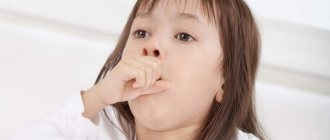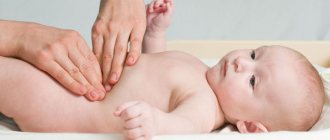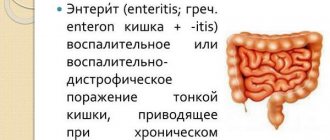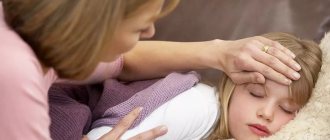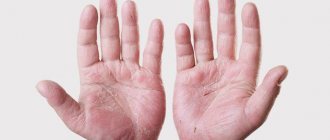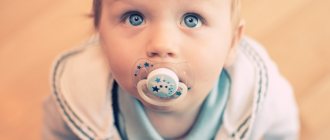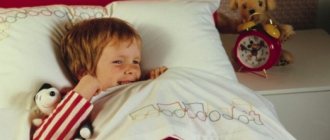Green stool in baby...
Green stool with mucus...
Green and foamy stool in a breastfed baby... The variety of options you see in your baby's diaper.
It is quite natural to worry and look for an answer - is this normal, or should the child be taken to the doctor?
In this article, you will get answers to your questions from a lactation consultant with 9 years of experience and will be able to cope with your worries.
Possible reasons
Why might a child develop green diarrhea? The reasons can be very different, they depend on the diet, age and health of the baby.
As soon as you notice this unpleasant phenomenon, you first need to try to understand why it happened. Some provoking factors are normal and should reassure parents, while others will indicate problems that will have to be resolved in the doctor’s office.
Reasons that should not cause concern
Meconium
The peculiarity of the stomach in the first 10 days of a child’s life explains the dark olive color of the stool.
Formation of the gastrointestinal tract
A greenish tint in the first year of life during breastfeeding is due to the underdeveloped gastrointestinal tract in newborns. Over time, his work returns to normal.
Breast-feeding
The liquid consistency is a consequence of the baby’s absorption of the mother’s fore-milk, low-fat breast milk.
Features of the mother's breast
If at 1 year of age the stool remains the same liquid and green, this may be due to tight breasts or inverted nipples in the mother. In this case, the formation of stool may take longer.
Maternal nutrition during breastfeeding
If a nursing mother’s diet contains a lot of carbohydrate-containing foods and green vegetables (you can find the nursing mother’s menu here), this can cause green diarrhea in the baby. It can be caused by spinach, broccoli, parsley, dill, green apples and pears, and cucumbers.
Artificial feeding
The use of milk formulas with a high iron content: NAN, Nutrilon and others.
Introduction of complementary foods
The first acquaintance with foods such as apples, broccoli, pears, and sweet porridge can lead to a change in the color of children's feces.
Nutritional Features
In older children (3-5 years), when the gastrointestinal tract is already fully formed, green diarrhea can be a consequence of poor nutrition. Namely: excessive consumption of carbohydrates (chocolate, sweets, baked goods, confectionery) and green foods (apples, pears, sorrel, dill, parsley, onions, spinach, lettuce).
Dangerous reasons
Dysbacteriosis due to improper introduction of complementary foods, previous intestinal infection, somatic disease, which were treated with antibiotics. Intestinal infections: shigellosis, escherichiosis, yersiniosis, rotavirus infection, campylobacteriosis and others. Dysentery. Salmonellosis due to consumption of raw or poorly thermally processed chicken eggs and fish.
If a child has green diarrhea, this fact cannot be ignored. It is necessary to carefully analyze the situation and draw initial conclusions about what could have caused such a stool.
If they are related to age characteristics and nutrition, and fit into the norms, there is no need to worry. But if you suspect a health problem, you should consult a doctor immediately. The accompanying symptoms will help clarify the situation.
When to see a doctor
If diarrhea passes without fever and lasts more than 2 days, you should contact your pediatrician; it may become chronic. This leads to disruption of intestinal motility and food digestion.
If an infectious disease is diagnosed, you should urgently seek medical help if the following symptoms occur:
- dry mouth, little tear production when crying;
- dark yellow urine;
- a red rash was found on the anus;
- a sharp decrease in the baby’s weight;
- rare urge to urinate.
You should immediately consult a doctor if there are 1-2 signs.
Contact an ambulance:
- When the disorder lasts 7-12 days and treatment does not help.
- A sharp increase in temperature.
- Frequent vomiting.
- Recession of the large fontanel and eyes.
- Volumetric amount of mucus, blood in the stool.
- Green, foamy stool with a sour odor.
It is important to contact your pediatrician promptly if the disorder is caused by taking antibiotics.
Associated symptoms
If a child has health problems, green diarrhea will not be the only symptom of the disease. The clinical picture is a whole set of symptoms. Therefore, you should observe the child and determine whether there are any other deviations from the norm in his condition.
Temperature
- green diarrhea and fever are signs of dysentery or salmonellosis.
Consistency
— foam is a sign of dysbacteriosis, intestinal infections; - green diarrhea with mucus and bloody clots - alarming signs of dysentery; - green diarrhea with mucus, but without blood - salmonellosis.
Hue
— dark green diarrhea in a child is a consequence of salmonellosis; - light - a common intestinal disorder.
Smell
- sour, smelling of rot, indicates dysbacteriosis; - foul, unbearable - intestinal infection.
Regurgitation and vomiting
— frequent regurgitation with green diarrhea in young children is a symptom of dysbacteriosis; - vomiting in older people may indicate dysentery; - profuse, continuous vomiting is a sign of salmonellosis.
General state
Anxiety, whims, crying, refusal to eat, lack of sleep - all these symptoms of green diarrhea indicate that the child most likely has something in pain. If he can already talk, he will complain of stomach pain. This indicates serious problems with the intestines.
If a child has green diarrhea without fever and other accompanying symptoms, he remains cheerful and active, there is no need to panic. Over time, this unpleasant phenomenon will cease to bother you, and everything will return to normal. But if the stool of such an unusual color is complemented by a whole bunch of deviations from the normal state, you need to urgently go to the hospital. But what to do before the doctor arrives?
Symptoms accompanying the malaise
If a baby has health problems, diarrhea is not the only sign of pathology. Depending on the cause of green diarrhea, the temperature rises. This indicates the progression of dysentery. However, it can also be confused with salmonellosis.
It is worth paying attention to the consistency of the stool. In this case, inclusions are distinguished:
- foam - appears due to a violation of the intestinal microflora;
- mucus with blood - considered a sign of dysentery;
- mucus is a manifestation of salmonellosis.
What to do?
“Enterosgel” is a sorbent for absorbing and removing toxins from the child’s body
Before going to the hospital if a child has green diarrhea, accompanied by fever, vomiting and deterioration in general condition, parents can be advised to take the following measures.
Give the child Oralit, Regidron, Enterodes in small portions - special saline solutions are sold in any pharmacy and replenish fluid loss. It is not recommended to drink it with plain water: it can only make vomiting worse. In accordance with age, give one of the sorbents: Smecta, Polypefan, Enterosgel. They absorb toxins and promote their elimination. No other medications, especially antibiotics, should be given to a child with green diarrhea before consulting a doctor. This can only worsen his condition. Do not stop breastfeeding, but reduce the daily dose of milk by a third. Do not go on a fasting break for more than 6 hours.
These activities will temporarily alleviate the child’s condition. But you cannot delay calling or visiting a doctor. There is an urgent need to make a diagnosis for immediate treatment.
Preventive measures
To prevent repeated green diarrhea and vomiting in an infant or older child, the following preventive measures should be regularly observed:
- Nursing mothers should adhere to a diet and avoid uncontrolled use of medications.
- For artificially-fed babies, select a formula after consulting with a pediatrician. Especially when there is a need to switch to milk formula from another manufacturer and a different name.
- The introduction of complementary foods should occur gradually, monitoring the child's reaction. It is recommended to keep a food diary, which will include the foods that the baby tried for the first time. If your introduction to a particular product resulted in an eating disorder or an allergic reaction, you should highlight it in red and try to offer it again after a few months.
- You should not pick up a pacifier and lick it to “clean” it. An adult's saliva contains many bacteria that can infect a child. He should have separate baby dishes and clean, sterilized pacifiers/pacifiers.
- After the age of three, you need to normalize your diet and limit your intake of carbohydrates and greens. Food should only be freshly prepared. If you have doubts about the quality and freshness of the product, it is better to refuse it. Children are not allowed to drink raw tap water.
- Teach your child the rules of hygiene and mandatory hand washing after visiting the toilet and public places.
The condition in which green diarrhea is observed should be under the strict supervision of parents. When there are no signs of illness, it is necessary to adjust the diet. If the baby is sick, then you cannot delay visiting the doctor.
Source
Diagnostics
In the hospital, based on the results of laboratory tests, doctors will more accurately determine why the child has green stool, whether this is normal or pathological. If necessary, the following diagnostic techniques will be performed:
stool analysis for dysbacteriosis; bacterial culture of feces and vomit; sigmoidoscopy - visual examination of the rectum; Analysis of urine; coprogram; general blood analysis; RNGA of blood to detect antibodies to salmonella.
During the diagnosis, it will be found out why the child has green stool, whether it is an indicator of any disease or not. If health problems are detected, treatment will be prescribed. If not, the doctor can only advise the parents what to do in the future so that the color of the children's stool becomes normal.
Provoking factors
Without diagnostics, it is not always possible to determine why a child has green diarrhea.
The most common causes of intestinal upset are:
- infection affecting the intestines;
- dysbacteriosis;
- liver pathologies;
- bleeding in the intestines.
The least risk to health comes from dysbacteriosis, which goes away (if measures are taken) in 1-3 days. If the stool does not return to normal after two days, it is recommended to immediately contact a specialist.
Intestinal infections are often the cause of loose green stools.
Possible reasons according to age category are shown in the table.
We have selected useful articles on the topic
The main causes of diarrhea during a trip to the sea and the best ways to eliminate them
22.11.2020
Why does colitis occur in the lower abdomen?
02.06.2019
What foods increase the process of gas formation and why?
02.06.2019
| Age | Causes |
| 0 – 3 months | Natural normalization of the functioning of the gastrointestinal tract and excretion of original feces (in the first days after childbirth) |
| 3 – 6 months | Introduction of complementary foods - a reaction to a new type of food or artificial feeding |
| 1 – 3 years | Intestinal infections causing diarrhea with green stool, fever and vomiting |
| 1 year – 5 years | Dysbacteriosis, characterized by short-term stool disorder, the appearance of mucus in the stool and the presence of abdominal pain |
| 36 years | Liver pathologies that, in addition to the main symptoms, cause discomfort in the hypochondrium on the right side |
Green stool with blood in a breastfed baby is considered a symptom of serious health problems. The cause of the pathological condition may be infection or congenital anomalies and diseases.
In some cases, stool upset may be caused by the introduction of complementary foods for infants.
Treatment
So, what to do if parents discover green diarrhea in their child? Everything will depend on the diagnostic results. If you have diseases, you will have to undergo a course of treatment.
Therapeutic diet. For dysbiosis, bacteriophages, probiotics, Acipol, Linex, Enterol, Bifidumbacterin, Bifilin, Bifiform are prescribed. For intestinal infections: antibiotics and chemotherapy drugs (Nevigramon, Nergam, Ercefuril, Furazolidone, Gentamicin, Kanamycin, Anamycin sulfate, Rifampicin, Tienam, Meronem, Ciprofloxacin, Ceftazidime), specific bacteriophages, lactoglobulins, enteral immunoglobulins, enterosorbents. Oral rehydration with Regidron, Gastrolit, Oralit, Citroglucosolan. Enzyme therapy: Pankurmen, Panzinorm forte, Pancreatin, Abomin-pepsin, Festal, Digestal, Creon, Mezim forte. Antiallergic drugs. Antidiarrheal drugs: Diarol, Imodium. Myotropic antispasmodics for pain relief: Papaverine, Drotaverine, Spasmomen 40.
If green diarrhea is detected in a child, parents should understand what is happening to him. Sometimes ordinary care can neutralize an unpleasant and disturbing shade. In the presence of pathologies, this is only possible with the help of qualified medical intervention and appropriate treatment. Otherwise, complications cannot be avoided.
Complications
If parents did not take care of their child’s green stool in a timely manner, and its cause was one of the serious diseases, this may result in complications, including:
convulsions at high temperatures; dehydration of the body; dysbacteriosis can lead to dermatitis, bronchial asthma, chronic gastroduodenitis, intestinal dyskinesia, proctosigmoiditis; intestinal infections if left untreated can result in neurotoxicosis, cerebral edema, electrolyte disturbances, infectious-toxic shock, sepsis, hemolytic-uremic syndrome, toxic-dystrophic state; consequences of dysentery - intestinal bleeding, pericolitis, rectal prolapse, arthritis, neuritis, encephalitis, dysbacteriosis, malnutrition, hypovitaminosis, anemia, pneumonia, pyoderma, otitis media.
In order not to encounter these dangerous consequences, it is necessary to consult a doctor in a timely manner, and even better, to prevent this phenomenon. Prevention is always much more pleasant and easier than treatment.
What is the danger of this condition?
The greenish liquid stool of a breastfed baby does not threaten his health in any way, since the digestive system is just getting used to working independently. But if the cause of the disorder is hidden in the pathological process, and the parents did not take care to provide adequate help in a timely manner, the development of:
- Convulsions due to fever, which cannot be brought down with conventional antipyretics.
- Exhaustion, weight loss, vitamin deficiency.
- Dehydration (dehydration). It is most dangerous for children. Characteristic signs of the pathological condition are lack of urination, dry lips and skin, sunken eyes, lethargy, severe weakness, pale face, drowsiness.
- Arthritis, neuritis, anemia, pneumonia and other severe pathologies caused by dysentery.
- Neurotoxicosis, cerebral edema, sepsis are the most dangerous consequences of untreated intestinal lesions.
Prevention
Prevention of green diarrhea in children involves regular adherence to the following activities and actions.
A nursing mother should follow a diet and, if possible, not take antibiotics. If your child is bottle-fed, consult your doctor about which formula is best to choose. Introduce complementary foods gradually. If green diarrhea is a reaction to a certain product, it is better to exclude it from the child’s diet for now and wait until the gastrointestinal tract is more fully formed. At an older age (after 3 years), normalize the child’s diet: there is no need to overfeed him with carbohydrates and greens. Adults should not lick baby's spoons or pacifiers. They can give him an intestinal infection with their saliva.
Have you noticed that your child has green diarrhea? In this case, first try to find out its cause, and then take some action.
The best option would be to consult a doctor at the slightest suspicion of health problems. This will reduce the risk of complications and allow you to be treated quickly and without consequences. And to prevent this from happening again in the future, you need to regularly engage in prevention.
New articles
we are in social networks
A condition such as green diarrhea in a child causes anxiety among parents. Unfortunately, not everyone knows about what causes this pathology and how to cope with it. There are several reasons that lead to diarrhea, and each of them requires attention from a doctor.
Most often, the disease is caused by pathogenic bacteria and viruses. If your child has a fever, a stomach ache and green diarrhea, you should consult a doctor.
Possible complications and prevention
With rotavirus, gastrointestinal complications are possible. In the stomach, the virus penetrates the intestinal mucosa and causes inflammation. The danger lies in dehydration, which leads to death without taking immediate rehabilitation measures.
Prevention of yellow diarrhea in infants and adults:
- maintain hygiene during food preparation;
- prepare food just before consumption;
- check the expiration date of the mixtures, the integrity of the packaging;
- wash food and hands before eating;
- do not give children fast food;
- maintain personal hygiene.
By putting into practice the rules for preventing yellow diarrhea, you can avoid the disease.
Yellow diarrhea requires treatment and referral to specialists.
When green diarrhea appears in a child, this sign does not always mean serious problems with his health. However, parents begin to resort to self-medication and identify the causes of diarrhea. This can harm the baby and complicate the existing situation. Therefore, diarrhea with a green tint requires medical intervention and proper treatment.
Causes
Causes of green diarrhea:
dysbacteriosis; intestinal infection; liver diseases; intestinal bleeding (rare).
Green-colored diarrhea appears in many newborns in the first days after birth. There is nothing dangerous in this, since meconium, the original feces, will be excreted from the child’s body over the course of several days.
In older children, green diarrhea is often a consequence of intestinal infections. In this case, the temperature may rise, weakness and abdominal pain, nausea and vomiting may occur. These are characteristic symptoms of intoxication of the body by pathogenic microflora - protozoa, viruses, bacteria and fungi. Read more about these symptoms →
Similar symptoms of green diarrhea occur in a child against the background of liver disease, only discomfort in the epigastric area and right hypochondrium may be added to them.
Dysbacteriosis is characterized by loose, greenish stools, with the presence of mucus and streaks of blood in advanced cases. In this case, diarrhea may periodically give way to constipation.
When you need medical help
Green diarrhea is not dangerous. Harm to the body can be caused by the causes that caused the symptoms of green diarrhea, as well as dehydration of the child’s body. Medical assistance should be in the following situations:
- The child developed green diarrhea with blood. Bloody spots or clots indicate internal bleeding or ulceration of the intestinal mucosa.
- Signs of dehydration are noticeable - severe thirst, dry skin and mucous membranes, a decrease in the volume of urine excreted, and its darkening.
- Other symptoms characteristic of an intestinal infection appeared - fever, severe weakness, nausea and vomiting.
- The urge to have a bowel movement occurs more than 10 times a day.
Signs of dehydration in a child
You can determine that a child has lost a large amount of moisture using the following criteria:
pronounced lethargy and calmness; reduction in the number of urinations, dark color of urine; skin that is dry to the touch, cracked lips; the appearance of circles under the eyes; retraction of the fontanel in young children.
Any of these signs requires urgent medical attention. Otherwise, dehydration can cause even more serious complications for the child.
How dangerous is green diarrhea in a child?
The following conditions can cause complications of green diarrhea:
dehydration - the younger the child, the more susceptible he is to this condition; loss of minerals and salts, which may cause seizures; hypovitaminosis and exhaustion; fissures and hemorrhoids, rectal prolapse.
Diarrhea in a child cannot be ignored. Disturbances in water, electrolyte and salt balance in the body cannot be compensated for by regular drinking; treatment must be carried out by a doctor using appropriate medications (for example, Glucose solution, Regidron, etc.).
Why is it dangerous?
Even a simple intestinal disorder can be dangerous for a child if measures are not taken to stop the diarrhea. The most common consequence of diarrhea is dehydration, leading to complete impotence and the body's inability to resist pathological processes. Green diarrhea and fever in a child can lead to seizures.
Diseases provoke the development of a number of pathologies:
- dysbacteriosis – bronchial asthma, dermatitis, gastroduodenitis and others;
- intestinal infections - cerebral edema, intoxication shock, dystrophy, sepsis and others;
- dysentery - bleeding in the intestines, intestinal prolapse, neuritis, dysbacteriosis, pericolitis, pneumonia and many others.
Green diarrhea in a child 5 years of age and younger is the most dangerous, since the body is not yet fully formed and is not able to withstand pathological processes.
From the video you will learn why a child has green stools and what parents should do in this case:
How to help your baby?
Green diarrhea in a child and fever are two frequent companions of pathology, which can worsen as dehydration occurs. This condition is most dangerous for children under one year of age. Due to severe fluid loss, the need to drink increases, so first aid will be to provide the child with clean drinking water.
If the baby is breastfed, before feeding you can give him 50 mg of an absorbent drug prescribed by the pediatrician. Absorbents destroy toxins and remove pathogenic microflora from the body, qualitatively softening the mucous membrane of the digestive tract and facilitating the absorption of food. For artificial babies, absorbents are added to the mixture (for example, Enterosgel).
In addition to the absorbent drug, older children can be given rice broth, which also enhances the removal of toxins from the body and restores intestinal functions.
You can try to bring down the temperature during diarrhea, which does not exceed 38.5°, on your own. To do this, you need to give the child water often and not put warm clothes on him. Antipyretics are allowed to be used only as prescribed by a doctor.
The danger of green diarrhea in a child
During loose stools, the baby is at risk of dehydration. If this symptom is accompanied by an increase in temperature, then the risk of electrolyte imbalance increases. In order to promptly help a child from such danger, parents need to know the accompanying signs:
- weakness;
- fatigue;
- drowsiness;
- urine volume decreases;
- change in urine color to dark;
- dry mouth;
- dry lips;
- circles around the eyes stand out;
- In infants, the fontanelle drains.
Due to dehydration and inactivity, the child develops seizures. This occurs due to loss of nutrients. In this case, hypovitaminosis is observed. Otherwise, dehydration leads to exhaustion. This condition provides favorable conditions for the formation of cracks in the anus. This can cause prolapse of hemorrhoids.
When children develop greenish, loose stools, parents should not diagnose it themselves. Additional signs will begin to confuse the picture, and the use of drugs, on the contrary, will blur the symptoms. Especially if you have diarrhea with blood, you should not delay visiting a doctor. At home, you can use remedies that will help avoid dehydration. Basic treatment for childhood diarrhea should be left to specialists.
The information on our website is provided by qualified doctors and is for informational purposes only. Don't self-medicate! Be sure to consult a specialist!
Author: Rumyantsev V. G. Experience 34 years.
Gastroenterologist, professor, doctor of medical sciences. Prescribes diagnostics and carries out treatment. Expert of the group for the study of inflammatory diseases. Author of more than 300 scientific papers.
Green diarrhea in a child can cause panic in inexperienced parents. The disorder occurs quite often in children. There are several possible causes, and not all of them pose a serious health threat.
What is absolutely forbidden to do?
If your baby has green diarrhea and his condition worsens, you should not self-medicate by offering him:
painkillers (Nurofen, Ibuprofen), which can blur the picture of the disease, the symptom of which is diarrhea; tetracycline antibiotics, which are often used for diarrhea in adults, but are highly toxic in children; medications intended for adolescents and adults (Imodium, Loperamide); force the child to eat; limit fluid intake for fear of new attacks of diarrhea or vomiting; offer raw vegetables and fruits, as well as heavy foods that irritate the digestive tract; put ice or a heating pad on your stomach.
Self-medication for childhood diarrhea may make the situation worse. It is necessary to seek help from a doctor.
In what cases is it necessary to urgently call a doctor?
Green diarrhea in a child is already a suspicious sign that you need to pay attention to, but not cause panic. Before calling a doctor, it is important to assess the baby’s well-being. Fever and abdominal pain are an urgent reason to call an ambulance, especially if we are talking about a child under 3 years old.
The doctor will not only determine the cause of the pathology, but will also prescribe a comprehensive course of treatment. As a rule, it consists of drugs that normalize the water-salt balance in the body (Regidron), sorbents (Smecta) and agents that restore intestinal microflora (Linex, Bifidumbacterin, etc.).
Medicines will also be prescribed to eliminate the root cause of green diarrhea in the child. For example, if the pathology arose against the background of an intestinal infection, it will be antibiotics (Sumamed, Levomycetin, etc.). The specialist will also determine a diet for the child, which will have to be followed for several days.
You can limit yourself to calling a local pediatrician at home if the child’s health is normal, but the green diarrhea does not stop - most likely, it is a symptom of dysbiosis. After the doctor confirms the diagnosis, the baby will be prescribed medications for outpatient treatment aimed at strengthening the body’s defenses and combating dysbiosis (Maxilak Baby, Hilak Forte, etc.).
Symptoms
When identifying problems with well-being in a one-year-old child (and in children older), green diarrhea will not be the only sign of a pathological process. Unpleasant symptoms are sure to be added to it:
- Increase in temperature. If a child has green diarrhea with a repulsive odor and a fever, this means an intestinal infection.
- Foamy stool. He talks about disrupted intestinal flora.
- Diarrhea with green, bloody, mucous streaks in a child is caused by intestinal infections, in particular shigellosis.
- Mucus discharge in multiple dark green stools is a sign of rapid multiplication of the Salmonella pathogen.
- Vomiting with green diarrhea in an infant indicates manifestations of dysbacteriosis. When similar symptoms are observed in older children, this clearly indicates that pathogens and pathogenic infections have entered the intestines.
Parents need to be extremely careful if their child experiences green vomiting without an increase in temperature or diarrhea. In such cases, it is necessary to provide the patient with specialist consultation, since the causes may be hidden in food poisoning, head injuries, serious pathologies of internal organs, even damage to the central nervous system.
When a child is restless, capricious, has green diarrhea, refuses food, and sleeps poorly, then all these symptoms are characteristic of serious intoxication and gastrointestinal diseases that require medical supervision. If there are no dangerous signs, the stool gradually returns to normal, the baby plays, moves actively and eats well - there is no reason to consult a doctor.
Prevention
Prevention of diarrhea with a green tint in a child consists of the following measures:
A woman who is breastfeeding should strictly follow the diet and, if possible, not take medications, especially antibiotics. A formula-fed infant with frequent recurrences of diarrhea should be examined by a pediatrician or pediatric gastroenterologist to diagnose the pathology and select an appropriate formula. The first complementary foods should be introduced gradually and carefully. The green color of diarrhea may be an individual reaction of the baby to any food product. In this case, you should refuse the food that provokes the pathology and wait until the digestive tract gets stronger. It is important to feed children over 3 years of age fully and correctly, avoiding excess amounts of high-carbohydrate foods and greens in the daily diet. Do not put a baby's pacifier or spoon in your mouth. Causative agents of intestinal infection may be present in the saliva of an adult.
If your baby has green diarrhea, you first need to find out the cause of the pathology, and then begin to act. It is best to consult a doctor immediately, which will reduce the likelihood of complications. To prevent green diarrhea from recurring in a child, it is important to devote time to prevention.
Author: Olga Rogozhkina, doctor, especially for Mama66.ru
Features of the treatment of yellow diarrhea in children of different ages
Infants under 1 year of age are seen by a pediatrician. Only a doctor can determine the exact treatment by establishing the cause of the disease.
Pharmacy drugs
At elevated temperatures, the doctor prescribes Aspirin and Paracetamol.
To remove toxic substances, children aged 3-5 years will need to be treated with the following drugs: “Activated carbon”, “Atoxil”, “Smecta”, “Enterosgel”.
To normalize the functioning of the intestinal microflora, probiotics are used: “Linex”, “Bifidumbacterin”, “Hilak-Forte”.
To improve digestion and better absorption, you will need “Creon”, “Mezim”, “Pancreatin”.
In case of an allergic reaction of the body, the following are prescribed to older children: “Alerzin”, “Zodak”, “Cetrin”.
Treatment of infection involves taking antibiotics as prescribed by a doctor for children over 5 years of age.
Home Remedies
Home remedies are used for a child if the disorder occurs without fever and the baby behaves normally.
- Rice water should be used for children over 3 months of age. It helps start digestion and gives an astringent effect. Take 2 tbsp. rice, cover with cold water. Pour 200 ml of water into a saucepan and boil. Add rice, cook for 40 minutes, stirring. Then let it cool and drain the water. Give 1 tbsp. 3 times a day.
- Dill water is used from 0 to 12 months. Reduces flatulence, improves digestion. Preparation: 1 tbsp. dill seeds pour 0.5 liters of water. Let cool, filter. Take the infusion before meals, 1-2 tsp.
Use home remedies carefully after consulting with your pediatrician over the phone. If you have serious symptoms, you should consult a doctor to receive comprehensive treatment after determining the exact cause of diarrhea.
Nutrition and diet
An important condition for the disorder is to give the baby plenty of fluids. If the child refuses the first time, offer it again after a while.
Why does my child have green diarrhea?
Green diarrhea is a fairly common phenomenon and most parents experience it. There may be several reasons for its occurrence, and not all of them are pathological in nature.
Liquid green stools can be a sign of an intestinal infection and require immediate action, it can act as one of the symptoms of dysbiosis, and then long-term treatment will be required, or it can simply be a baby’s reaction to eating certain foods or changing their usual diet.
Let us consider the causes of children's liquid feces in more detail:
A child has green diarrhea due to an infection.
If green stool and acute diarrhea are accompanied by abdominal pain, a significant increase in temperature and other signs of disruption of the baby’s normal condition, then this may indicate the presence of an intestinal infection. It can be bacterial or viral in nature, and can also be caused by fungi or parasites. At the first suspicion of an intestinal infection, you should call a doctor at home. First aid for this condition are electrolytic solutions, the effect of which is to replenish the loss of fluid and minerals.
It is very important to recognize the onset of the disease in time and prevent dehydration, as it can pose a danger to the health and life of the baby. Signs of dehydration in a child under one year of age include dry lips and skin, lethargy, lethargy, infrequent urination, with the urine acquiring a pronounced dark color, dark circles around the eyes, and recessed fontanel. To prevent dehydration, when symptoms of lack of water in the body appear, the child should begin to be hydrated with special solutions. Such products are sold in pharmacies, and you can also prepare them yourself at home.
Dark green loose stool from dysbiosis
The causes of green diarrhea in a child often lie in a violation of the composition of the intestinal microflora. This condition is called dysbiosis. It can be caused by an allergic reaction, disruption of the immune system, improper use of antibiotics, poor nutrition and other factors. With dysbacteriosis in the child’s intestines, the number of beneficial microorganisms decreases and the number of pathogenic microorganisms increases. The result is such phenomena as green diarrhea in a child, bloating and flatulence, severe colic, allergic skin rash and others.
Only a doctor can make a diagnosis of “dysbacteriosis” after receiving the results of laboratory tests of the baby’s stool. The course of treatment usually includes taking antibiotics and bacteriophages to destroy harmful microflora. After this, in order to restore normal intestinal microflora, the doctor prescribes probiotics and prebiotics. Sorbents may also be prescribed to help remove toxins.
Breastfeeding a baby can prevent the appearance of dysbacteriosis, but only if the mother adheres to proper nutrition. If breastfeeding is not possible for one reason or another, then it is advisable to choose a suitable formula for the child. Pediatricians recommend giving preference to fermented milk and probiotic mixtures.
Green diarrhea from complementary feeding
The reasons for the appearance of green diarrhea in a one-year-old child can be much simpler, for example, switching to a new formula or a different type of food. Green stool can be a consequence of drinking cow's milk, fruits, juices or large amounts of food. This phenomenon may also be associated with poor nutrition of the mother.
The health of a small child is a reason that makes parents constantly worry. Therefore, it is better to monitor the diet of the baby and the nursing mother. However, in some cases, green diarrhea in a child is not dangerous. This phenomenon quite often accompanies the baby’s first feeding, especially if it is fruit juice.
Green stool in baby
One of the main reasons for green stool is improperly organized breastfeeding.
In the mammary gland, relatively speaking, two types of milk are produced: fore and hind. Foremilk is rich in water and carbohydrates and is more liquid. If we draw an analogy with the nutrition of an adult, it is as if you and I were drinking tea.
Hind milk, it is thicker, contains fats and proteins. It is more filling, and it is its intake that is important for infant weight gain. It's like having a plate of mashed potatoes and a cutlet with you.
